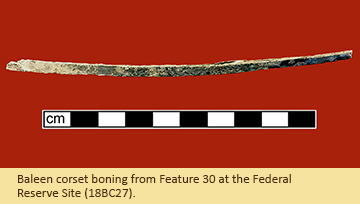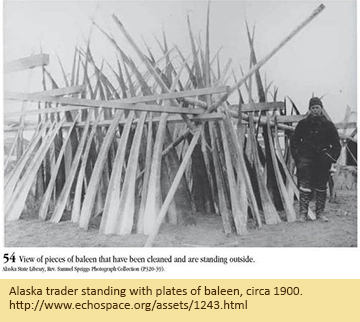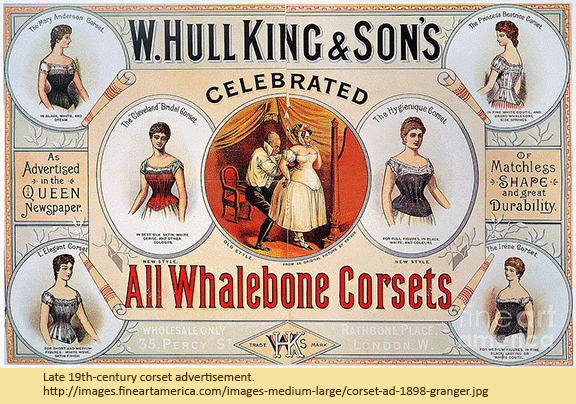Curator's Choice 2017
A "Whale" of a Well-Shaped Waist, 19th Century Style
May 2017
By Patricia Samford, MAC Lab Director
 While certainly not the most photogenic artifact in the collections at the Maryland Archaeological Conservation Lab, this six inch long strip of “whalebone” did not have to look good to be effective. It spent its useful life hidden from view, ensuring ladies the hourglass silhouette prescribed by Victorian fashion standards. Recovered from a Baltimore privy filled between 1850 and 1870, this unusual object was boning from an undergarment known as a corset.
While certainly not the most photogenic artifact in the collections at the Maryland Archaeological Conservation Lab, this six inch long strip of “whalebone” did not have to look good to be effective. It spent its useful life hidden from view, ensuring ladies the hourglass silhouette prescribed by Victorian fashion standards. Recovered from a Baltimore privy filled between 1850 and 1870, this unusual object was boning from an undergarment known as a corset.
 Baleen, commonly known as whalebone, is actually a keratinous hard tissue that forms in brush-like plates in the some aquatic mammals of the Cetacea order (MacGregor 1985). In whales in the Mystacoceti suborder, including the humpback, right, sperm and blue whale, these plates serve to filter the crustacean krill from seawater, which they then eat. Both flexible and strong, baleen was well-suited to the manufacture of a number of items, including combs, collar stiffeners, picture frames, fan blades and riding whips (Lauffenburger 1993:220).
Baleen, commonly known as whalebone, is actually a keratinous hard tissue that forms in brush-like plates in the some aquatic mammals of the Cetacea order (MacGregor 1985). In whales in the Mystacoceti suborder, including the humpback, right, sperm and blue whale, these plates serve to filter the crustacean krill from seawater, which they then eat. Both flexible and strong, baleen was well-suited to the manufacture of a number of items, including combs, collar stiffeners, picture frames, fan blades and riding whips (Lauffenburger 1993:220).
Baleen was apparently first used in women’s fashion in the western world in the 1590s, when the hooped petticoats known as farthingales were stiffened with strips of the substance (Lauffenburger 1993:219). It soon became an important component of corsets and stays, undergarments used to shape and hold the torso into a prescribed shape. Baleen strips could be bent to the contours needed for the silhouette demanded by the fashion of the day. The strips—sometimes dozens per corset—would be inserted into narrow channels sewn into the body of the undergarment (Holloway Scott 2010).
By the mid-19th century, baleen began to be replaced by steel boning, which was less expensive and easier to manufacture (Holloway Scott 2010). Perhaps its presence in the circa 1850-1870 privy assemblage is explained by the arrival of newer technology or may reflect broader cultural outlooks about wearing corsets and campaigns for dress reform (Steele 2001).

| References |
|
| Holloway Scott, Susan |
| 2010 |
More About Corsets: Baleen Ho! Two Nerdy History Girls. Blog post dated April 7, 2010. Website accessed 1-31-2017. http://twonerdyhistorygirls.blogspot.com/2010/04/more-about-corsets-baleen-ho.html. |
|
| Lauffenburger, Julie A. |
| 1993 |
Baleen in Museum Collections: its Sources, Uses, and Identification. Journal of the American Institute for Conservation. 32(3):213-230. |
|
| MacGregor, Arthur |
| 1985 |
Bone, Antler, Ivory and Horn; The Technology of Skeletal Materials Since the Roman Period. Routledge Library Editions, Archaeology. Volume 41. Routledge, New York. |
|
| Steele, Victoria |
| 2001 |
The Corset: A Cultural History. Yale University Press, New Haven, Connecticut. |
|
|